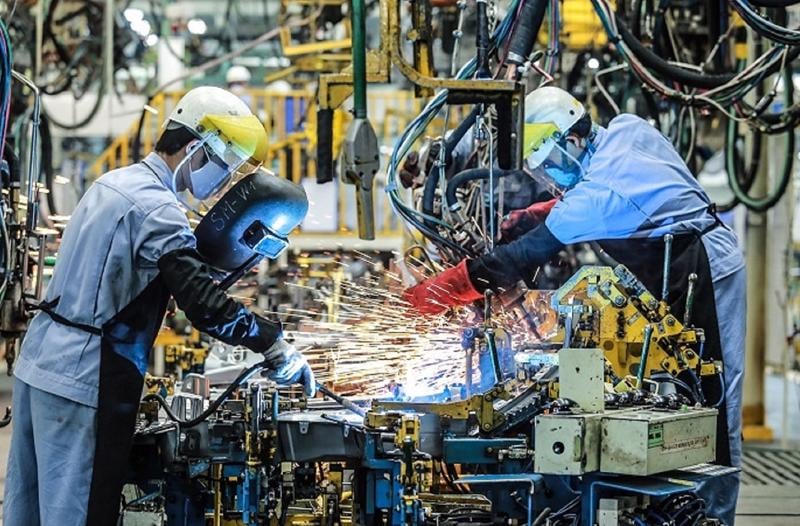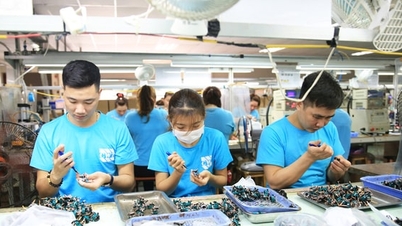Production growth, employment increase again
Vietnam’s manufacturing sector continued to grow modestly in February 2024, with both output and new orders rising for the second month running. The sustained growth momentum helped employment pick up again.
 |
| New orders continued to improve, supporting employment growth in February 2024. |
According to S&P Global experts, Vietnam's manufacturing sector continued to grow modestly in February 2024 as both output and new orders increased for the second consecutive month. The sustained growth momentum helped employment increase again, while business confidence rose to a high level.
The Manufacturing Purchasing Managers' Index™ (PMI) report stated: "Vietnam's manufacturing sector recorded 50.4 in February, up slightly from 50.3 in January and remaining above the 50-point threshold for the second consecutive month."
New orders increased slightly for the second month running, as new orders from abroad improved. However, the rate of growth in new export orders slowed, and the increase was only marginal.
Of which, there was an increase in the consumer goods and basic investment goods sectors, but a decrease in the intermediate goods sector.
Rising new orders encouraged manufacturers to increase staff numbers for the first time in four months, and the increase was the highest in a year. However, businesses tended to hire only temporary new workers.
With employment rising and new order growth remaining subdued, businesses were able to clear backlogs of work for the first time in three months.
Businesses have used finished goods inventories to meet order requirements, thereby causing post-production inventories to continue to decrease.
One issue that needs to be mentioned is that businesses purchasing input goods continued to face extended delivery times from suppliers in February, due to shipping delays.
"Delays in shipments coincided with higher transport costs due to higher oil prices, pushing input costs up significantly in February, although the rate of increase was the smallest since September last year," according to S&P Global PMI.
Of note, capital goods producers experienced particularly strong increases in input costs. Some producers passed on the burden of higher input costs to customers, resulting in a slight increase in selling prices after a slight decrease in the previous survey. The modest price increases reflect firms’ efforts to limit price increases due to competitive pressures.
Plans to expand production and launch new products contributed to a rise in business confidence mid-quarter, and optimism about output also reflected expectations for growth in new orders. Business confidence reached a one-year high with nearly 55% of survey respondents expressing optimism.
" The positives from the latest PMI survey include a rebound in employment and a one-year high in business confidence. However, overall growth remains relatively weak, and this has led businesses to remain cautious in their purchasing and inventory holding activities," said Andrew Harker, chief economist at S&P Global Market Intelligence.
Source





![[Photo] Bustling Mid-Autumn Festival at the Museum of Ethnology](https://vphoto.vietnam.vn/thumb/1200x675/vietnam/resource/IMAGE/2025/10/4/da8d5927734d4ca58e3eced14bc435a3)
![[Photo] Solemn opening of the 8th Congress of the Central Public Security Party Committee, term 2025-2030](https://vphoto.vietnam.vn/thumb/1200x675/vietnam/resource/IMAGE/2025/10/4/f3b00fb779f44979809441a4dac5c7df)
![[Photo] General Secretary To Lam attends the 8th Congress of the Central Public Security Party Committee](https://vphoto.vietnam.vn/thumb/1200x675/vietnam/resource/IMAGE/2025/10/4/79fadf490f674dc483794f2d955f6045)






















































![[VIDEO] Summary of Petrovietnam's 50th Anniversary Ceremony](https://vphoto.vietnam.vn/thumb/402x226/vietnam/resource/IMAGE/2025/10/4/abe133bdb8114793a16d4fe3e5bd0f12)
![[VIDEO] GENERAL SECRETARY TO LAM AWARDS PETROVIETNAM 8 GOLDEN WORDS: "PIONEER - EXCELLENT - SUSTAINABLE - GLOBAL"](https://vphoto.vietnam.vn/thumb/402x226/vietnam/resource/IMAGE/2025/7/23/c2fdb48863e846cfa9fb8e6ea9cf44e7)































Comment (0)